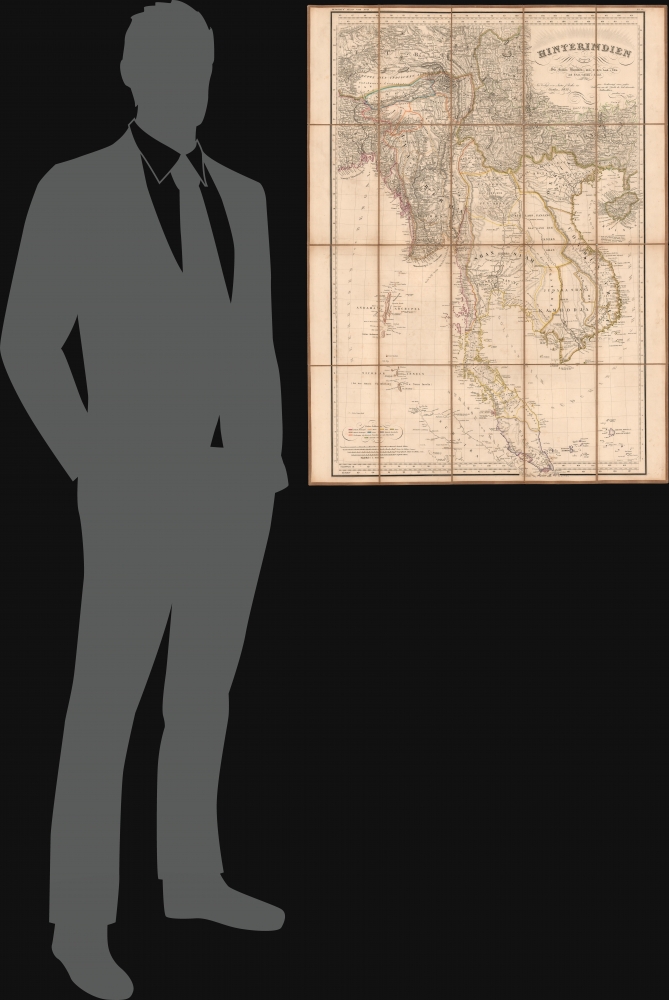1832 Berghaus 'Atlas von Asia' Map of Southeast Asia: Thailand, Malaya, Cambodia, Vietnam, Burma
Hinterindien-berghaus-1832-2
Title
1832 (dated) 39 x 27 in (99.06 x 68.58 cm) 1 : 4000000
Description
A Closer Look
Coverage embraces from the Ganges River delta to Hainan Island and from Tibet (as far as Lhasa) to Singapore. The map benefits from cartography collected by Francis Buchanan-Hamilton, who accompanied the 1795 Michael Symes mission to Ava. We also recognize the influence of the maps produced in the wake of the 1826 John Crawfurd Mission to Ava and the subsequent 1828 Crawfurd Mission to Siam. It is the first map to effectively consolidate this array of new data, making it the most engrossingly detailed map of these regions to appear in the first half of the 19th century. The map is dedicated to Buchanan-Hamilton.Publication History and Census
This map was published in 1832 by Heinrich Berghaus and Justus Perthes. It was engraved in Berlin by Wilhelm Brose. The map is no. 8 of Berghaus's Atlas von Asien, all the individual maps of which are exceedingly desirable. We know of examples in the David Rumsey Collection, the Bibliothèque nationale de France, and several German collections, but little or no presence on the private market.CartographerS
Heinrich Karl Wilhelm Berghaus (May 3, 1797 – February 17, 1884) was a German (Prussian) geographer who founded the Geographische Kunstschule in Potsdam and trained several important German geographers and cartographers of the late 19th century, including August Heinrich Petermann and his nephew Hermann Berghaus. The elder Berghaus also was a friend and associate of Alexander von Humboldt, producing some of the maps in his publications. In 1837, he inherited the Daniel Gottlob Reymann (1759 – 1837) monumental Geographischer Specialatlas von Deutschland. Berghaus is best known for his own influential and wide-ranging atlases, namely Atlas von Asien, published between 1833 and 1837, and Berghaus' Physikalischer Atlas, published in multiple editions in the 1830s - 1840s. Although Atlas von Asien was a commercial failure, it was regarded as a work of supreme quality, boosting the reputation of the publisher Justus Perthes and setting up their next collaboration, Berghaus' Physikalischer Atlas, for success. More by this mapmaker...
Johan Georg Justus Perthes (September 11, 1749 - May 2, 1816) was one of the most important German cartographic engravers of the 19th century. He was born in the Thuringian town of Rudolstadt, the son of a court physician. In 1778, he began working as a bookseller in Gotha. Perthes began his publishing empire shortly thereafter with the 1784 issue of the famed survey of European nobility known as the Almanac de Gotha. In the next year, 1785, he founded the cartographic firm of Justus Perthes Geographische Anstalt Gotha. His son Wilhelm Perthes (1793 - 1853) joined the firm in 1814. Wilhelm had prior publishing experience at the firm of Justus Perthes' nephew, Friedrich Christoph Perthes, who ran a publishing house in Hamburg. After Justus Perthes died in 1816, Wilhelm took charge and laid the groundwork for the firm to become a cartographic publishing titan. From 1817 to 1890. the Perthes firm issued thousands of maps and more than 20 different atlases. Along with the visionary editors Hermann Berghaus (1797 - 1884), Adolph Stieler (1775 - 1836), and Karl Spruner (1803 - 1892), the Perthes firm pioneered the Hand Atlas. When Wilhelm retired, management of the firm passed to his son, Bernhardt Wilhelm Perthes (1821 – 1857). Bernhardt brought on the cartographic geniuses August Heinrich Peterman (1822 - 1878) and Bruno Hassenstein (1839 - 1902). The firm was subsequently passed to a fourth generation in the form of Berhanrd Perthes (1858 – 1919), Bernhard Wilhelm's son. The firm continued in the family until 1953 when, being in East Germany, it was nationalized and run as a state-owned enterprise as VEB Hermann Haack Geographisch-Kartographische Anstalt Gotha. The Justus family, led by Joachim Justus Perthes and his son Wolf-Jürgen Perthes, relocated to Darmstadt where they founded the Justus Perthes Geographische Verlagsanstalt Darmstadt. Learn More...
Wilhelm Brose (17xx - 18xx) was a German engraver active in the early 19th century. He engraved for Herman Berghaus and the Justus Perthes firm. He is likely related to Karl Heinrich Brose (1783 - 1861), also an engraver with Perthes, Berghaus, and Flemming. Learn More...




